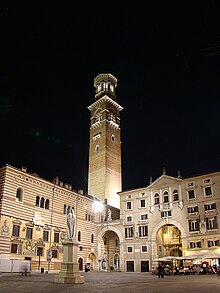Verona is a city straddling the Adige river in Veneto, northern Italy, with approximately 265,000 inhabitants and one of the seven chef-lieus of the region. It is the second largest city municipality in the region and the third of northeast Italy. The metropolitan area of Verona covers an area of 1,426 km2 (550.58 sq mi) and has a population of 714,274 inhabitants. It is one of the main tourist destinations in northern Italy, owing to its artistic heritage, several annual fairs, shows, and operas, such as the lyrical season in the Arena, the ancient amphitheatre built by the Romans.
The city has been awarded World Heritage site status by UNESCO because of its urban structure and architecture.
The Roman military settlement in what is now the centre of the city was to expand through the cardi and decumani that intersect at right angles. This structure has been kept to the present day and is clearly visible from the air. Further development has not reshaped the original map. Though the Roman city with its basalt-paved roads is mostly hidden from view it stands virtually intact about 6 m below the surface. Most palazzi and houses have cellars built on Roman artifacts that are rarely accessible to visitors.Piazza delle erbe, near the Roman forum was rebuilt byCangrande I and lords of Verona, using material (such as marble blocks and statues) from Roman spas and villas.
Verona is famous for its Romanamphiiteatre, theArena found in the city's largest piazza, thePiazzaBra. Completed around 30 AD, it is the third largest in Italy after Rome'sColosseum and the arena atCapua. It measures 139 metres long and 110 metres wide, and could seat some 25,000 spectators in its 44 tiers of marble seats. The ludi (shows and gladiator games) performed within its walls were so famous that they attracted spectators from far beyond the city. The current two-story facade is actually the internal support for the tiers; only a fragment of the original outer perimeter wall in white and pink limastone from valpollicea, with three stories remains.The interior is very impressive and is virtually intact, and has remained in use even today for public events, fairs, theatre and open-aired opera during warm summer nights.
The Arco dei Gavi (Gavi Arch) was built in the 1st century AD, and is famous for having the name of the builder engraved on it, a really rare case in the architecture of the epoque. It originally straddled the main Roman road into the city, now the Corso Cavour. It had been demolished by the French troops in 1805 and was rebuilt in 1932.





Bellisimo :)
ОдговориИзбришиCity of love!
ОдговориИзбришиbeauty...
ОдговориИзбришиMoja svetska putnica!!! kiss
ОдговориИзбришиbeau texte
ОдговориИзбриши